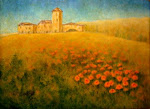Shadowed by the Matterhorn, the small, picturesque Lago D’Orta
(Lake Orta) is surrounded by forests with a wild and melancholy beauty.
Just eight miles long and less than two miles wide, Lake Orta is one of the smallest and least known of northern Italy's sub-Alpine lakes. The German
philosopher Friedrich Nietzsche, who visited the lake in 1882, believed the experience changed his life forever. He inscribed the date "von Orta an"
("from Orta onwards") as a preface to his masterpiece Thus Spake Zarathustra. I can’t guarantee that going to Lake Orta to paint will change your life forever,
but I can promise you’ll come away with some of the most beautiful images
you’ve every put down on canvas. Other 19th-century writers enchanted by
its quiet beauty include the French novelist Honoré de Balzac, who wrote rapturously of this "gray pearl in a green jewel-box", and Robert Browning whose
poem "By the Fireside" contemplates the beauty of a setting where "Alp
meets heaven in snow", describes the lakeside village of Pella as a luminous "speck of white... in the evening-glow".
With all this glowing praise, you might imagine Orta San Giulio, the main
town of Lake Orta, to be swarming with tourists, but it’s not. Many visitors ignore this little gem and flock eastwards to the nearby, much larger Lago Maggiore. Their loss is your gain, as it keeps the crowds to a minimum.
Parking in the town center can be a bit tricky, well okay, more than tricky: impossible, as it is traffic-free. But there are a few small parking lots up on the main road and the walk down into town is an easy one. Don’t try parking on the main
road; there are blue lines on each side that indicate resident parking only.
Parking tickets are common sites and the fines are steep and payable on site.
In town, you’ll find more than enough paint-worthy subjects: stone
archways, flower-choked balconies, and courtyards tucked behind ornate iron gates. Pastel-washed 16th and 17th-century buildings house small shops, and
winding alleyways zigzag to a maze of narrow streets. Piazza Motta is the
perfect location to set up. This broad, flagged square runs parallel to the waterfront and is partially shielded from the hustle and bustle of the jetty by an impressive row of chestnut trees. Colorful cafés spread out across the piazza if you prefer to sketch while sipping a glass of the local wine.
Certainly, you must allow time to visit Isola San Giulio. From the jetty of
Orta San Giulio, boats leave every ten minutes for the five-minute trip to the island in the middle of the lake. Centuries-old legend says the island was home to dragons, but don’t be scared off, St Julius, the island's namesake and founder of its basilica, arrived at Lake Orta over 1,600 years ago and dispatched the dragons with his sword. So if you were looking forward to painting dragons, I’m sorry to disappoint
you. But don’t worry, there’s plenty more to keep your artist’s eye excited.
Even without dragons, the island has a magical “feel.” Take the flagged alleyway, which flits in and out of the sunlight as it weaves around the island’s
interior. There are many quiet places to stop and sketch. I emphasize “quiet,” as the alleyway is signed: “the way of silence,” in one direction and “the way of meditation” in the other. You will also come across small signs in various
languages that remind you this is a place for reflection such as: "If you can
be yourself, you are everything." And, “Listen to the water, the wind,
your steps."
Lovely old palazzi, draped in wisteria and trumpet vines, ring the
waterfront of Isola San Giulio, making it an ideal spot to sit and paint or
sketch. The views from the waterfront back to the mainland town of Orta San Giulio are luscious.
I recommend bringing along some bottled water if you plan to stay on the island for a few hours. There is only one small gift shop where water is available.
Back on the mainland, Orta San Giulio’s pièce de résistance demands a
bit of a climb (325ft above the lake if you’re counting) up to the Sacro Monte
di San Francesco. This hilltop plateau laid out with 20 chapels dedicated to
the life of Saint Francis of Assisi is very cool. All the chapels are unique in design, reflecting the fact that building took place over a 200-year period.
Sacro Monte was designated a National Park in 1980. The chapels are
built like a village, amid meandering paths, woods, and a plethora of
wildflowers, all this, plus incredible views of Lake Orta lying dreamily below
on her mountain bed.
Do bring water, and I suggest a picnic. There’s a lot to paint and you’ll
really need at least half a day. Once you’re here, your only dilemma will be
what to paint first.
Since this is a National Park, be sure to follow the rules and stay on the designated paths so as not to trample nature’s balance. If you do go off the paths,
there are groundskeepers in the area who will quickly get you back on track.
Buon Viaggio!





No comments:
Post a Comment
Thank you for your comment. Grazie per i complimenti.
Note: Only a member of this blog may post a comment.